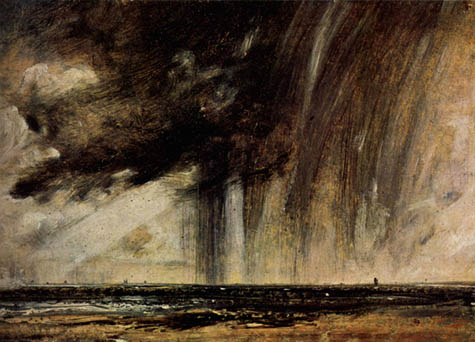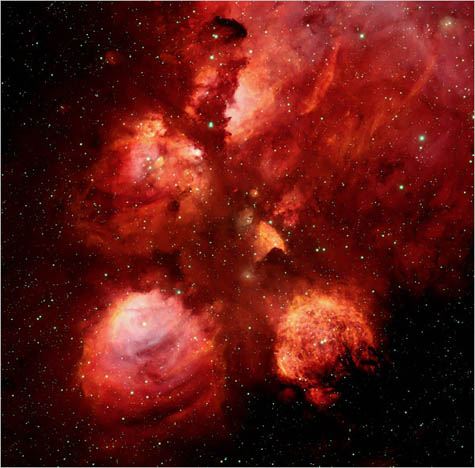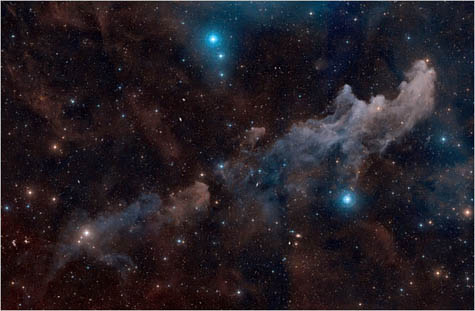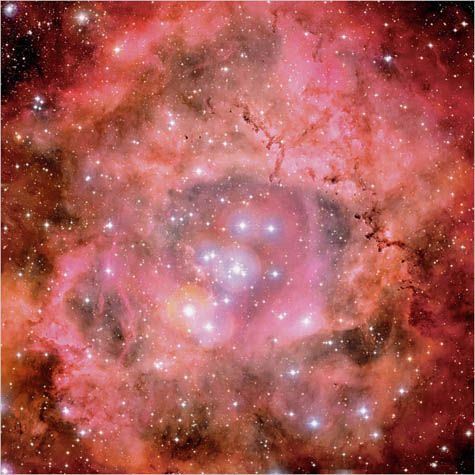Golden Scans
 [Image: The Pelican Nebula, photographed by Charles Shahar at the Palomar Observatory].
[Image: The Pelican Nebula, photographed by Charles Shahar at the Palomar Observatory].A new book of photographs curated, cropped, and digitally reprocessed by Michael Benson (previously mentioned on BLDGBLOG here) has been reviewed by the New York Times as something you could flip through "for hours and never be bored by the shapes, colors and textures into which cosmic creation can arrange itself." The book shows us "stars packed like golden sand, gas combed in delicate blue threads, piled into burgundy thunderheads and carved into sinuous rilles and ribbons, and galaxies clotted with star clusters dancing like spiders on the ceiling."
The above image of the Pelican Nebula, photographed by Charles Shahar at Caltech's Palomar Observatory, brings to mind the later sky studies and weather paintings of John Constable, in particular Constable's Seascape Study with Rain Cloud (1827). As if there are nebulas here on earth with us, moving through the sky (and through art history).
Stars, here, would be chemical weather that emits light.
 [Image: John Constable, Seascape Study with Rain Cloud (1827); originally spotted at Pruned].
[Image: John Constable, Seascape Study with Rain Cloud (1827); originally spotted at Pruned].But such landscape comparisons only go so far; here are a few more photographs from the book, which you can buy at Amazon.


 [Images: (top) The bewilderingly beautiful Cat's Paw Nebula, photographed by T.A. Rector at the University of Alaska, Anchorage; (middle) The Witch Head Nebula, photographed by Davide De Martin at the Palomar Observatory; (bottom) The Rosette Nebula, photographed by J.C. Cuillandre (Canada France Hawaii Telescope) and Giovanni Anselmi (Coelum Astronomia)].
[Images: (top) The bewilderingly beautiful Cat's Paw Nebula, photographed by T.A. Rector at the University of Alaska, Anchorage; (middle) The Witch Head Nebula, photographed by Davide De Martin at the Palomar Observatory; (bottom) The Rosette Nebula, photographed by J.C. Cuillandre (Canada France Hawaii Telescope) and Giovanni Anselmi (Coelum Astronomia)].That final image shows us "3000 cubic light years of gas... heated to a temperature of over 10 million degrees Fahrenheit." To my discredit, I have never thought of volumes of space in terms of "cubic light years" before—it's an extraordinary unit of measurement. Perhaps someday it could even be applied to data: teraflops be damned, our harddrives will be filled with cubic light years of information.





Comments are moderated.
If it's not spam, it will appear here shortly!
lightyear is a unit of physical distance, teraflops are units of performance (floating point operations per second), hard drives are filled with units of data - usually *byte or *bit. somehow I don't see hard sciences ever interchanging units like that. though there probably will be a comparable vastness in the *byte family some day. the question may be, after the atomic transistor size limit is solved, what will yottabyte flash drives look like?
Actually I get bored very quickly with these things. Yes I realize that the manipulation is for our benefit to more easily see what we're looking at, but really, in the end it's just so many colorized explosions with lots of pretty dots . . . .
I'd rather see more "honest" images.
You mean you'd rather see a seemingly unending strings of 0s and 1s, which these images actually are, if you want to be irreducibly "honest"? Somehow I think you've lost an unfortunate amount of your capacity to be astonished. Unfortunate indeed.
Sorry if this is in the wrong place (and you could delete it if you want) but I just wanted to ask what happened with the 'Quick Links' section? And the list of blogs relevant to different topics like landscape or architecture? I liked reading those and found them very useful on your site.
Yup, love the site but miss the links. Less reason to visit now
Jennie, and fumanchuck, this post might address your questions: Quick Links 1.
I'm astonished and amazed by what these images represent - I just don't like the heavy colorization . . . . .
I would enjoy seeing unmanipulated, undoctored images.
Post a Comment